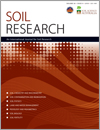SR17025Revisiting the wet and dry ends of soil integral water capacity using soil and plant properties
Because plant properties have been disregarded in most approaches which are estimated soil available water for plant (PAW), so, the objective of this study is to include the plant physiological properties to redefine upper and lower limits of PAW. Indeed, in our proposed approach is hypothesized that soil materials with similar texture, mechanical and hydrological properties but under different plants can lead to different water availability values. This work is expected to contribute to a deeper understanding of water availability for a given soil under different managements and/or plants.




